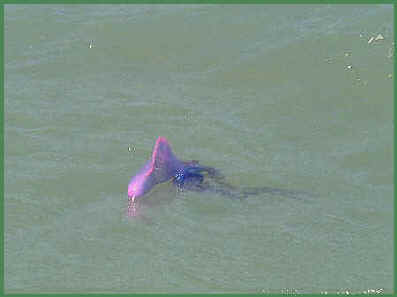 MARINE LIFE
MARINE LIFE
of Southeastern
North America
of and by the Atlantic Ocean
and the Gulf of Mexico
Other than Whales and Dolphins
and the Manatee
including inshore and offshore waters
of coastal Florida and Texas
A list compiled by Armas Hill
With those seen during FONT tours and pelagic trips
with an (*)
Photo at upper
right: the jellyfish known as the PORTUGUESE MAN-OF-WAR
Codes:
All of the following in
this list either along the coast or offshore
FL in Florida
TX in Texas
(p)
pelagically
(ASC:xx) refers to plate number of photo in the "National
Audubon Society Field Guide to Seashore Creatures"
(FGCF:xx) refers to the page with an
illustration in the book "A Field Guide to Coastal Fishes, from Maine to Texas", by
Val Kells & Kent Carpenter, 2011.
These classifications by the ICUN (International Union for Conservation of
Nature)
of Threatened & Near-threatened species;
(t1): critically endangered
(t2): endangered
(t3); vulnerable
(nt): near-threatened
(ph) species with a photo in the FONT website
Links:
A
Listing of upcoming Focus On Nature Tours
Upcoming
FONT Birding & Nature Tours in North America
FONT
Past Tour Highlights
Links, in the following list, to:
Sea
Turtles Fish
Corals
& Jellyfish Mollusks (Shells)
Arthropods
(including Crustaceans & Echinoderms)
Other Links:
A List & Photo Gallery of
Texas Birds, in 2 Parts
Mammals of Texas
Butterflies of Texas
Dragonflies & Damselflies of Texas
Amphibians & Reptiles of Texas
A Directory of Photos in the this Website

MARINE, or SEA, TURTLES
(Reptiles)
- Leatherback (Sea) Turtle (t1) (ph) (*)
______ FL TX
Dermochelys coriacea
The Leatherback Sea Turtle is the world's largest turtle. It can weigh half a
ton. It is a deep
diver, able to go to a depth of about 5,000 feet.
- Loggerhead (Sea) Turtle (t2) (ph) (*)
______ FL TX
Caretta caretta

A Loggerhead Sea Turtle photographed during a
FONT pelagic trip
(photo by Alan Brady)
- Kemp's Ridley (Sea) Turtle (t1) (*)
______ FL TX
Lepidochelys kempii
The Kemp's Ridley is globally the most endangered of the sea
turtles, but it is the species most commonly found in the Texan waters of
the Gulf of Mexico.
The primary nesting area for the species is in the Mexican state of
Tampaulipas, where Rancho Nuevo has been the only known major nesting beach
for the species in the world.
A secondary nesting population has been established at the Padre Island
National Seashore in Texas.
- Green (Sea) Turtle (t2) (ph)
______ FL TX
Chelonia mydas
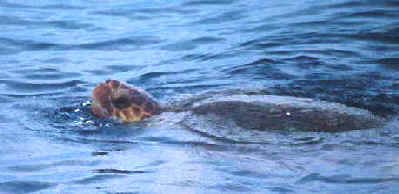
A Green Sea Turtle photographed during a FONT tour
- Atlantic Hawksbill
(t1) (ph) ______ FL TX
Eretmochelys imbricata
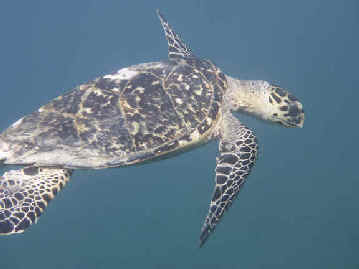
The Atlantic Hawksbill
(photo courtesy of Diane Allison)
An excellent book about sea turtles is "Voyage
of the Turtle - in Pursuit of the Earth's Last Dinosaurs", by Carl
Safina, Owl Books, 2007.
FISH
Click the above link to a list of
marine fish of southeastern North America: with 357 species
INVERTEBRATES
including those of the OPEN OCEAN:
CNIDARIANS
(including corals & jellyfish)
STONY CORALS (Class Anthozoa)
- Staghorn Coral ______ FL
(ASC:55)
Acropora cervicornis
- Elkhorn Coral ______ FL
(ASC:32)
Acropora palmata
- Lettuce Coral ______ FL
(ASC:33)
Agaricia agaricites
- Starlet Coral ______
FL
TX (ASC:16)
Siderastrea radians
- Reef Starlet Coral ______
FL (ASC:14)
Siderastrea siderea
- Porous Coral ______ FL TX
(ASC:9)
Porites astreoides
- Clubbed Finger Coral ______ FL TX
(ASC:13)
Porites porites
- Knobbed Brain Coral ______ FL
(ASC:4)
Diploria clivosa
- Labyrinthine Brain Coral ______
FL TX (ASC:3)
Diploria labyrinthiformis
- Common Brain Coral (ph) ______ FL
(ASC:2)
Diploria strigosa
Diploria strigosa
is also called Smooth Brain Coral or Symmetrical Brain Coral.
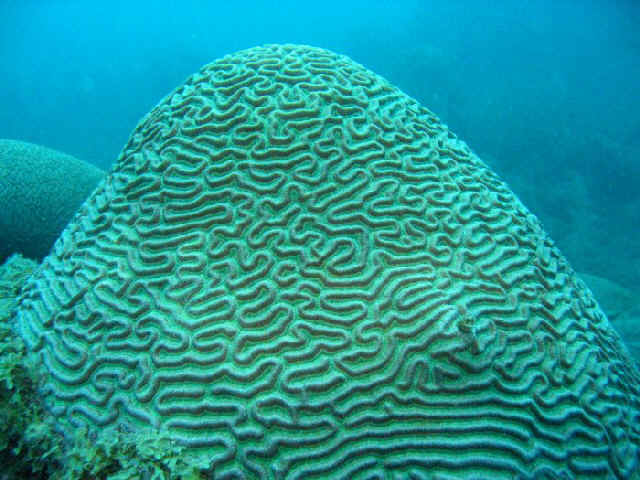
Symmetrical Brain Coral
- Rose Coral ______ FL
(ASC:175)
Maniccina areolata
- Large Star Coral ______
FL TX (ASC:11,174)
Montastrea cavernosa
- Common Star Coral (ph) ______ FL
(ASC:10)
Montastrea annularis

Common Star Coral and Neon Goby
- Northern Stony Coral ______ FL
(range: Cape Cod to Florida)
Astrangia danae
- Ivory Bush Coral ______ FL
(AS:35)
Oculina diffusa
- Meandrine Brain Coral ______ FL
(ASC:5)
Meandrina meandrites
- Stokes' Star Coral ______
FL (ASC:7)
Dichocoenia stokesii
- Pillar Coral ______ FL
(ASC:6)
Dendrogyra cyclindrus
- Flower Coral ______
FL (ASC:173,198)
Eusmilia fastigiata
JELLYFISH (Class Scyphozoa)
- Crown Jellyfish ______ FL
(ASC:503)
Nausithoe punctata
- Purple Jellyfish ______
(ASC:508)
Pelagica noctiluca
The Purple Jellyfish occurs in large swarms, which appear as glowing white
balls at night.
- Sea Nettle ______ FL
TX
(ASC:506,510)
Chrysaura quinquecirrha
- Lion's Mane ______ FL
(ASC:514)
Cyanea capillata
The Lion's Mane is the largest jellyfish in the world. Specimens up to 8
feet wide have been found.
In Sir Arthur Conan Doyle's story, "The Adventure of the Lion's
Mane", Sherlock Holmes solves a homicide caused by contact between the
victim and this medusa in a tidepool.
- Upside-down Jellyfish ______ FL
TX (ASC:509)
Cassiopeia xamachana
- Moon Jellyfish (ph) (*) ______
FL TX
(ASC:502)
Aurelia aurita
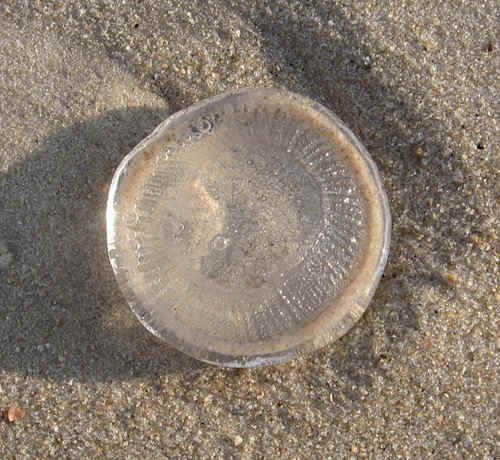
Moon Jellyfish
Above on a beach; below in the water

- Cannonball Jellyfish (*)
______ FL TX
(ASC:507,514)
Stomolophus meleagris
HYDROIDS (Class Hydrozoa, Order Siphonophora: not true jellyfish)
- Portuguese Man-of-war (*)
______ FL TX (ASC:512,513)
Physalia physalis
MOLLUSKS (SHELLS)
SEASHELLS are made by MOLLUSKS.
MOLLUSKS are invertebrate animals that produce shells of one or two pieces
that wholly or partially enclose a soft body.
SHELLS are the skeletons of MOLLUSKS. Like the internal skeleton
(endoskeleton) of a mammal, the external skeleton (exoskeleton) of mollusks
function both for protection and as a place for muscle attachment.
A SHELL found on a beach is the skeletal remnant of a dead MOLLUSK.
MOLLUSKS are either snail-like animals with one shell (UNIVALVES, or
GASTROPODS), or clam-like animals with two shells (BIVALVES). The two
shells of a BIVALVE are held tightly together when the animal is alive.
A third group of MOLLUSKS are the CEPHALOPODS, including SQUIDS and
OCTOPUSES. These animals lack external shells, having instead internal or
rudimentary shells.
GASTROPODS (Class
Gastropoda): snail-like mollusks with a one -part shell
- Rough-girdled Chiton
______ FL (ASC:375)
Ceratozona squalida
- Mesh-pitted Chiton
______ FL TX
Ischnochiton papillosus
- Florida Slender Chiton
______ FL (ASC:378)
Stenoplax floridana
- Common Bee Chiton
______ FL
Chaetopleura apiculata
- Cayenne Keyhole Limpet ______
FL TX (ASC:384)
Diodora cayenensis
- Bleeding Tooth
(ph) ______ FL
Nerita peloronta
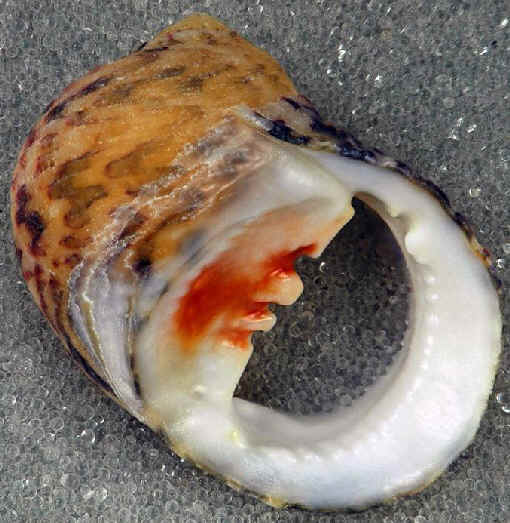
Bleeding Tooth
- Checkered Nerita
______ FL TX
Nerita tessellata
- Marsh Periwinkle ______ FL
TX (ASC:473)
Littorina irrorata
- Angulate
Periwinkle ______ FL
Littorina irrorata
- Boring Turret
Snail ______ FL TX (ASC:399)
Turritella acropora
- Variegated Turret Snail ______ FL
Turritella variegata
- Common Worm Snail
______ FL (ASC:475)
Vermicularia spirata
- Common Sundial ______ FL
TX
(ASC:433)
Architectonica nobilis
- Costate Horn Snail ______ FL
(ASC:396)
Cerithidea costata
- Ladder Horn Snail ______ FL
Cerithidea
scalariformis
- Black Horn Snail ______ FL
(ASC:401)
Batillaria minima
- Ivory Cerith ______ FL
Cerithium ebureum
- Florida Cerith ______ FL
TX
(ASC:402)
Cerithium floridanum
- Lettered Cerith ______ FL
Cerithium literatum
- Dwarf Cerith ______
FL
Cerithium variabile
- Variable Bittium ______ FL
TX
Bittium varium
- Common Purple Sea Snail ______ FL
TX (ASC:466)
Janthina janthina
- Angulate Wentletrap ______ FL
TX (ASC:395)
Epitonium angulatum
- Common Slipper Snail ______ FL
TX
(ASC:462)
Crepidula fornicata
- Eastern White Slipper Snail
______ FL TX
Crepidula plana
- Fighting Conch ______ FL
TX
Strombus alatus
- Queen Conch (ph) ______ FL
(ASC:435)
Strombus gigas
- Four-spotted Trivia ______ FL
(ASC:450)
Trivia quadripunctata
- Atlantic Deer Cowrie _____ FL
TX
Cypraea cervus
- Atlantic Gray Cowrie ______ FL
Cypraea spadicea
- Flamingo Tongue (ph)
______ FL (ASC:449)
Cyphoma gibbosum

Flamingo Tongue
- Shark Eye (or Moon Shell)
(ph)
______ FL TX (ASC:467)
Polinices duplicatus
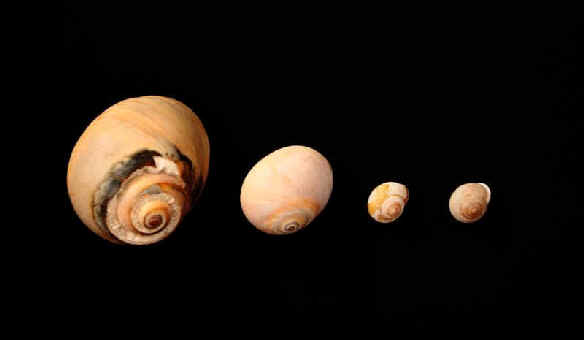
Some Shark Eyes, or Moon Shells
(photo by Marie Gardner)
- Common Baby's Ear ______
FL TX
(ASC:465)
Sinum perspectivum
- Emperor Helmet ______ FL
(ASC:434)
Cassis madagascariensis
- Scotch Bonnet (ph) ______ FL
TX (ASC:454)
Phalium granulatum
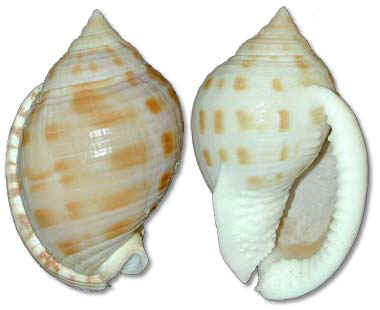
The Scotch Bonnet, on each side
- Angular Triton ______
FL (ASC:419)
Cymatium femorale
- Apple Murex ______ FL
TX
(ASC:437)
Phyllonotus pomum
- Lace Murex ______ FL
(ASC:438)
Chicoreus florifer
- Rock Snail ______ FL
TX
(ASC:415)
Thais haemastoma
- Atlantic Oyster Drill ______ FL
(ASC:407)
Urosalpinx cinerea
- Mottled Dove Snail ______
FL
Columbella mercatoria
- Greedy Dove Snail ______ FL
TX
(ASC:406)
Anachis avara
- Lunar Dove Snail ______
FL TX (ASC:453)
Mitrella lunata
- Channeled Whelk (ph) ______ FL
(ASC:417)
Busycon canaliculatum

A grouping of Channeled Whelks
(photo by Marie Gardner)
- Knobbed Whelk ______ FL
Busycon carica
- Lightning Whelk ______ FL
TX (ASC:427,428)
Busycon contrarium
- Crown Conch ______
FL TX (ASC:429)
Melongena corona
- Mud Dog Whelk ______ FL
(ASC:452)
Nassarius obsoletus
- Mottled Dog Whelk ______ FL
TX
(ASC:413)
Nassarius vibex
- Florida Horse Conch ______ FL
TX (ASC:426)
Pleuroploca gigantea
Pleuroploca gigantea is the
largest snail on the Atlantic and Gulf Coasts of the US. It is 24 inches
long & 10 inches wide.
- True Tulip Snail ______
FL TX (ASC:421)
Fasciolaria tulipa
- Banded Tulip Snail ______ FL
TX
(ASC:422)
Fasciolaria hunteria
- Netted Olive ______ FL
(ASC:440)
Oliva reticularis
- Variable Dwarf Olive
______ FL TX
Olivella hiplicata
- Lettered Olive ______
FL TX (ASC:441,442)
Oliva sayana
- Beaded Miter ______
FL
(ASC:403)
Mitra nodulosa
- Junonia ______
FL TX
(ASC:423)
Scaphella junonia
- Common Nutmeg ______
FL
TX
(ASC:416)
Cancellaria reticulata
- Common Marginella ______ FL TX
(ASC:439)
Prunum apicinum
- Mouse Cone ______ FL
(ASC:431)
Conus mus
- Alphabet Cone ______
FL (ASC:430)
Conus spurius
- Stearns' Cone ______ FL
TX
(ASC:432)
Conus stearnsi
- Concave Auger ______
FL
(ASC:397)
Terebra concava
- Common Atlantic Auger ______ FL
TX
(ASC:398)
Terebra dislocata
TURRET or TURRID SHELLS: Family TURRIDAE
- Cuban Turrid ______ FL in
south Florida
Crassispira cubana
The Cuban Turrid has been said to be Crassispira mesoleuca.
- Sanibel Turret ______ FL
(PS:65) in west Florida, and the Bahamas
Crassispira sanibelensis
The Sanibel Turret (above) and the Tampa Turrid (below) were both described
in 1939.
- Tampa Turrid ______ FL
(PS:65) in west Florida
Crassispira tampaensis
- Star Turrid ______ FL
(PS:65) North Carolina to the Gulf of Mexico, and in the West
Indies
Cochlespira radiata
- Elegant Star Turrid ______
FL both sides of Florida
Cochlespira elegans
- Gabb's Mangelia ______ FL
(PS:65) Florida, Gulf of Mexico, West Indies
Glyphostoma gabbi
- White-banded Drillia ______
FL (PS:65) Florida and the West Indies
Monilispira albomaculata
- Knobby Drillia ______ FL
(PS:65) south Florida, the Gulf of Mexico, and the West Indies
Monilispira leucocyma
- Collared Drillia ______
FL in south Florida
Monilispira monilis
The Collared Drillia was described in 1939.
- Glorious Drillia ______
FL Florida, the West Indies
Neodrillia cydia
The Glorious Drillia was described in 1943.
- Clapp's Drillia ______
FL in west Florida
Cerodrillia clappi
The Clapp's Drillia was described in 1939.
- Thea Drillia ______ FL
(PS:63) in west Florida
Cerodrillia thea
- Janet's Turret ______ FL
(PS:65) Florida, the West Indies
Fenimorea janetae
Janet's Turret was described in 1934.
- Moser's Turret ______
FL North Carolina to Florida, and the Gulf of Mexico
Fenimorea moseri
- Oyster Turret ______ FL
(ASC:404)
Crassispira ostrearum
- Common West Indian Bubble
______ FL (ASC:443)
Bulla occidentalis
- Warty Sea Cat ______ FL
(ASC:211)
Dolabrifera
dolabrifera
- Spotted Sea Hare ______ FL TX
(ASC:210)
Aplysia dactylomela
- Ragged Sea Hare ______ FL
TX
(ASC:148)
Bursatella leachi
- Common Lettuce Slug ______
FL
(ASC:212)
Tridachia crispata
- Saltmarsh Snail ______ FL
TX
(ASC:446,448)
Melampus bidentatus
BIVALVES (Class Bivalva)
- Atlantic Nut Clam ______ FL
TX (ASC:329)
Nucula proxima
- Veiled Clam ______ FL
Solemya velum
- Turkey Wing ______ FL
TX
Arca zebra
- White-bearded Ark ______
FL TX (ASC:323)
Barbatia candida
- Blood Ark ______ FL
TX (ASC:369)
Anadara ovalis
- Ponderous Ark ______ FL
TX (ASC:367)
Noetia ponderosa
- Comb Bittersweet ______ FL
(ASC:365)
Glycymeris pectinata
- Ribbed Mussel ______ FL
TX (ASC:295)
Ischadium demissum
- Flat Tree Oyster ______ FL
TX (ASC:357)
Isognomon alatus
- Atlantic Pearl Oyster ______ FL
TX
Pinctada radiata
- Stiff Pen Shell ______
FL (ASC:298,354)
Atrina rigida
- Saw-toothed Pen Shell ______ FL
TX (ASC:299)
Atrina serrata
- Kitten's Paw (ph) ______ FL
TX (ASC:361)
Plicatula gibbosa
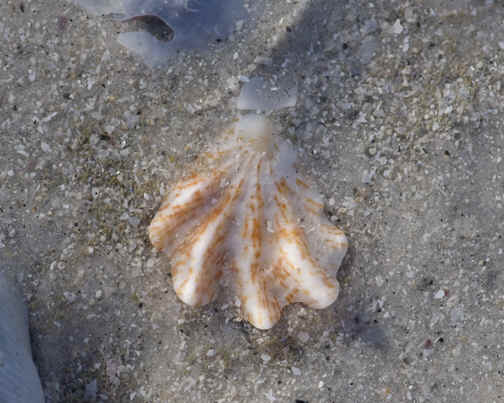
- Atlantic Bay Scallop ______ FL
TX (ASC:353)
Argopecten irradians
- Lion's Paw (ph) ______ FL
TX (ASC:352)
Nodipecten nodosus
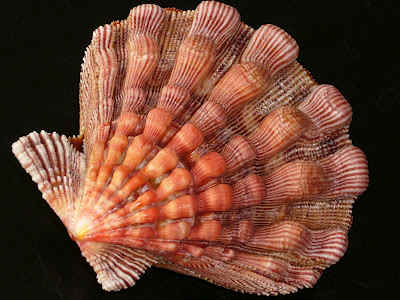
Above & below: Lion's Paw
Below, as it appears in the sea
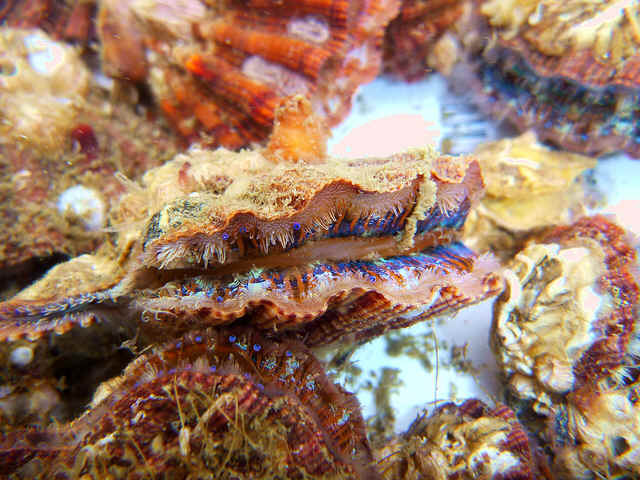
- Atlantic Thorny Oyster ______ FL
TX (ASC:349)
Spondylus americanus
- Antillean File Shell ______ FL
TX (ASC:325)
Lima pellucida
- Rough File Shell ______
FL (ASC:350)
Lima scabra
- Common Jingle Shell ______ FL
TX (ASC:345)
Anomia simplex
- Eastern Oyster ______ FL
TX (ASC:289)
Crassostrea virginica
- Coon Oyster ______ FL
(ASC:359)
Dendrostrea frons
- Broad-ribbed Cardita ______
FL TX (ASC:324)
Carditamera floridana
- Carolina Marsh Clam ______ FL
TX (ASC:337)
Polymesoda caroliniana
- Buttercup Lucine ______
FL TX (ASC:333)
Anodontia alba
- Tiger Lucine ______ FL
TX (ASC:332)
Codakia orbicularis
- Cross-hatched Lucine ______ FL
(ASC:331)
Divaricella
quadrisulcata
- Leafy Jewel Box (ph) ______ FL
TX (ASC:347)
Chama macerophylla
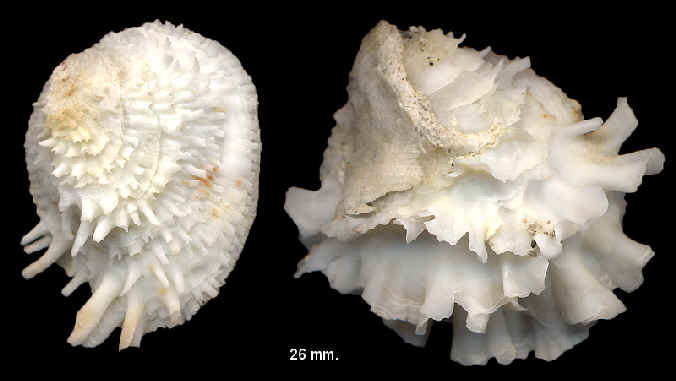
Leafy Jewel Box
- Florida Spiny Jewel Box ______ FL
TX (ASC:348)
Arcinella cornuta
- Atlantic Strawberry Cockle
______ FL
(ASC:362)
Americardia
media
- Giant Atlantic Cockle ______ FL
TX (ASC:366)
Dinocardium robustum
- Common Egg Cockle ______
FL TX (ASC:330)
Laevicardium
laevigatum
- Morton's Egg Cockle ______
FL TX (ASC:342)
Laevicardium mortoni
- Yellow Cockle ______ FL
TX (ASC:363)
Trachycardium
muricatum
- Disk Dosinia ______ FL
TX (ASC:334)
Dosinia discus
- Sunray Venus ______ FL
TX (ASC:302)
Macrocallista nimbosa
- Southern Quahog ______ FL
TX (ASC:336)
Mercenaria
campechiensis
The Southern Quahog is
heavier and broader than its close relative, the Northern Quahog.
Although their ranges overlap, the Southern Quahog has not been
exploited for food nearly as much as its northern relative.
- Northern Quahog (Clam) ______
FL TX (ASC:338)
Mercenaria mercenaria
- False Angel Wing ______ FL
TX (ASC:297)
Petricola
pholadiformis
- Alternate Tellin ______ FL
TX
Tellina alternata
- Iris Tellin ______ FL
TX
Tellina agilis
- Candy Stick Tellin ______
FL
Tellina similis
- Coquina ______
FL TX (ASC:321)
Donax variabilis
The Spanish fort at St, Augustine in Florida was made with
Coquina about 400 years ago.
- Jackknife Clam ______ FL
TX (ASC:305)
Tagelus plebeius
- Common Razor Clam ______ FL
(ASC:308)
Ensis directus
- Angel Wing ______ FL
TX (ASC:296)
Cyrtopleura costata
- Striated Wood Piddock ______ FL
TX (ASC:313)
Martesia striata
- Common Shipworm ______
FL TX (ASC:311)
Teredo navalis
SQUIDS & OCTOPODS (Class Cephalopoda)
- Caribbean Reef (or Briar) Octopus
(ph) ______ FL
Octopus briareus
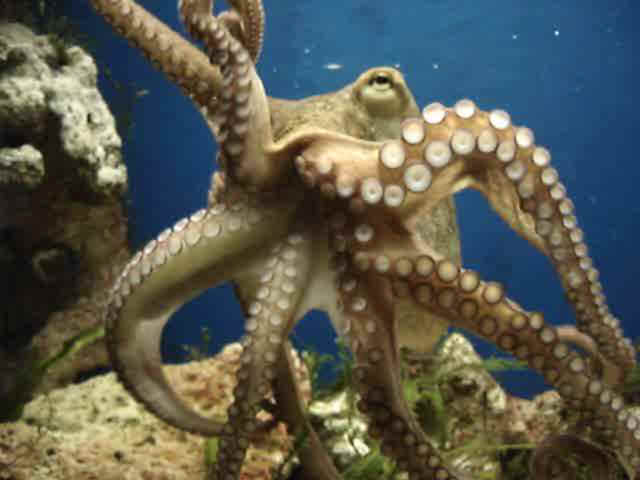
A Caribbean Reef, or Briar Octopus
- Joubin's Octopus ______ FL
Octopus joubini
- Long-armed Octopus ______ FL
Octopus macropus
- Common Atlantic Octopus ______
(ASC:480)
Octopus vulgaris
ARTHROPODS (Class Merostomata)
- Horseshoe Crab (ph) ______ FL (ASC:666)
Limulus polyphemus
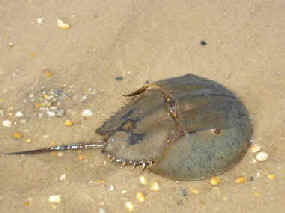
Horseshoe Crab
(photo by Rise Hill)
CRUSTACEANS
- Brown Shrimp ______ FL
TX
Penaeus aztecus
- Pink Shrimp ______ FL
TX (ASC:609,611)
Penaeus duorarum
- White Shrimp ______ FL
TX
Penaeus setiferus
- Common Shore Shrimp ______ FL
TX (ASC:607)
Palaemonetes vulgaris
- Pederson's Cleaning Shrimp
______ FL (ASC:616)
Periclimenes pedersoni
- Spotted Cleaning Shrimp ______ FL
(ASC:617)
Periclimenes
yucatanicus
- Brown Pistol Shrimp ______ FL
(ASC:622)
Alpheus armatus
- Banded Coral Shrimp ______ FL
(ASC:618)
Stenopus hispidus
- Grabham's Cleaning Shrimp
______ FL (ASC:615)
Lysmata grabhami
- Red-lined Cleaning Shrimp
______ FL TX
(ASC:613)
Lysmata wurdemanni
- Sand Shrimp ______ FL
(ASC:593)
Crangon septemspinosa
- Caribbean Lobster (or Caribbean
Lobsterette) ______ FL
Metanephrops binghami
- West Indian Spiny Lobster
______ FL TX
(ASC:625)
Panulirus argas
- Spanish Lobster ______
FL (ASC:626,627)
Scyllarides
aequinoctialis
- Ridged Slipper Lobster ______ FL
TX
Scyllarides nodifer
- Flat-browed Mud Shrimp ______ FL
TX (ASC:621)
Upogebia affinis
- Say's Porcelain Crab ______ FL
TX (ASC:647)
Porcellana sayana
- Land Hermit Crab ______
FL (ASC:685)
Coenobita clypeatus
- Giant Hermit Crab ______ FL
TX (ASC:682)
Petrochirus
diogenes
- Striped Hermit Crab ______ FL
TX (ASC:684)
Clibanarius vittatus
- Bar-eyed Hermit Crab ______ FL
TX (ASC:680)
Dardanus fucosus
- Star-eyed Hermit Crab ______ FL
(ASC:687)
Dardanus venosus
- Long-clawed Hermit Crab ______
FL TX (ASC:677)
Pagurus longicarpus
The Long-clawed Hermit Crab is the most common hermit crab
along the Atlantic Coast. It normally uses the shells of the periwinkle,
mud snail, or oyster drill.
- Flat-clawed Hermit Crab ______ FL
TX (ASC:676)
Pagurus pollicaris
The Flat-clawed Hermit Crab is often found in the shells of Moon
Snails and the larger whelks.
- Atlantic Mole Crab ______ FL
TX (ASC:690)
Emerita talpoida
- Sponge Crab ______
FL (ASC:670)
Dromia erythropus
- Lesser Sponge Crab ______ FL
TX (ASC:669)
Dromidia antillensis
- Purse Crab ______ FL
TX (ASC:635)
Persephona punctata
- Flame-streaked Box Crab ______ FL
TX (ASC:671)
Calappa flammea
- Yellow Box Crab ______ FL
(ASC:673)
Calappa gallus
- Calico Crab (ph) ______ FL
TX (also called "Dolly Varden")
Hepatus epheliticus
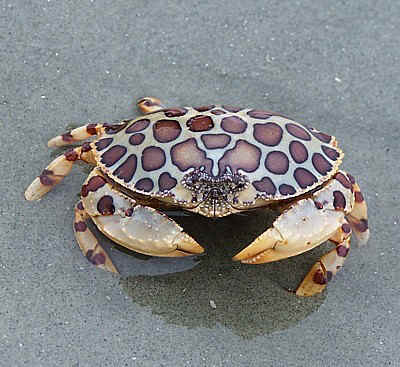
Calico Crab
- Flat-browed Crab ______ FL TX
(ASC:633)
Portunus depressifrons
- Sargassum Crab (ph) _____
FL TX (ASC:658)
Portunus sayi
The Sargassum Crab is normally a creature of the high
seas and a member of the Sargasso Weed community.
- Blue Crab ______
FL
TX (ASC:657)
Callinectes sapidus
- Jonah Crab ______ FL
(ASC:653)
Cancer borealis
- Coral Crab (ph) ______
FL (ASC:648)
Carpilius corallinus
- Warty Crab ______
FL
Eriphia gonagra
- Flat Mud Crab ______ FL
TX (ASC:645)
Eurypanopeus depressus
- Stone Crab ______ FL
TX (ASC:642)
Menippe mercenaria
- Commensal Crabs ______ FL
TX (ASC:634)
Pinnotheres spp.
- Sally Lightfoot (ph)
______ FL (ASC:649)
Grapus grapus
- Mottled Shore Crab ______ FL TX
Pachygrapus crassipes
- Flattened Crab ______ FL
Plagusia depressa
- Wharf Crab ______ (ASC:665)
Sesarma cinereum
- Great (or Giant Blue) Land Crab (ph)
______ FL TX
(ASC:632)
Cardisoma guanhumi
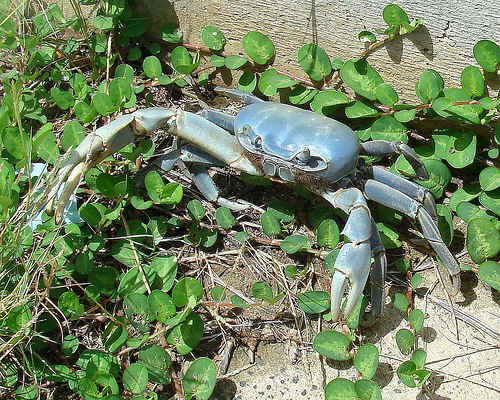
Great, or Giant Blue Land Crab
- Black Land Crab ______
FL
TX
Gecarcinus lateralis
- Mountain Crab ______ FL
(ASC:638)
Gecarcinus ruricola
- Ghost Crab (ph) ______ FL
TX (ASC:631)
Ocypode quadrata
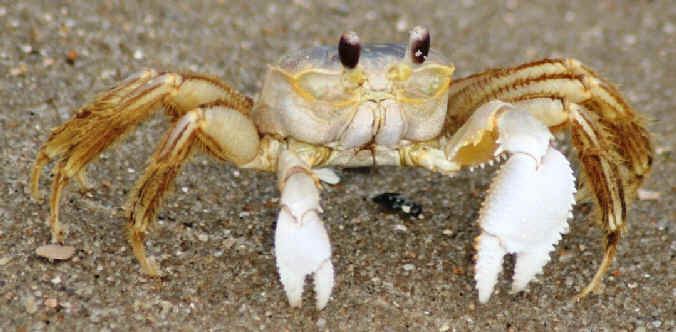
Ghost Crab
- Brackish-water Fiddler ______ FL TX
(ASC:629)
Uca minax
- Sand Fiddler ______
FL
TX (ASC:628)
Uca pugilator
- Mud Fiddler ______ FL TX
Uca pugnax
- Common Spider Crab ______ FL TX
(ASC:656)
Libinia emarginata
- Spiny Spider Crab ______
FL (ASC:640)
Mithrax spinosissimus
- Atlantic Decorator Crab ______ FL
Stenocianops furcata
- Arrow Crab ______
FL
TX (ASC:574)
Stenohynchus
seticornis
- Pourtales' Long-armed Crab
______ FL
Parthenope pourtalesii
- Saw-toothed Crab ______ FL
Parthenope serrata
ECHINODERMS
ASTEROIDS (Class Stelleroidea): including
the sea stars and brittle stars
"Sea Star" is preferred to "Star Fish" as that term is a
misnomer as "fish" are finny vertebrates.
- Banded Luidia ______ FL
TX
(ASC:564)
Luidia alternata
- Striped Luidia ______
Luidia clathrata
- Plate-margined Sea Star ______
Astropecten articulatus
- Cushion Star (ph) ______ FL
(ASC:541)
Oreaster reticulatus
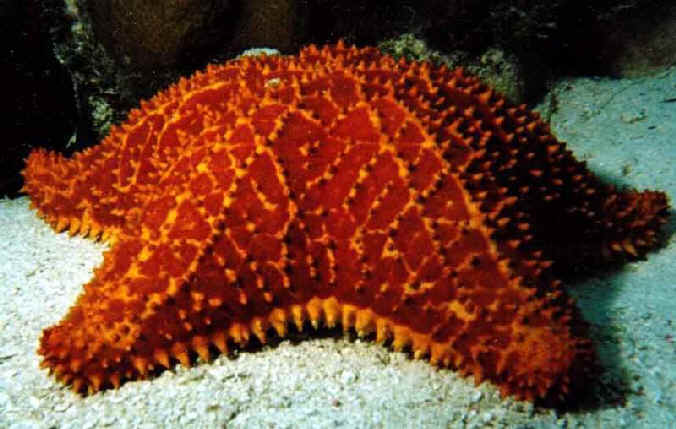
Cushion Star
- Thorny Sea Star ______ FL
(ASC:549)
Echinaster sentus
- Common Comet Star
______ FL
Linckia columbiae
- Forbes' Common Sea Star
______ FL TX
(ASC:557,558)
Asterias forbesi
- Caribbean Basket Star ______
FL (ASC:573)
Astrophyton muricatum
- Short-spinned Brittle Star ______
FL
Ophioderma brevispina
- Dwarf Brittle Star ______ FL
(ASC:568)
Axiognathus squamatus
- Atlantic Long-spined Brittle Star ______
FL TX
Ophiothrix angulata
- Reticulate Brittle Star ______ FL
(ASC:565)
Ophionereis reticulata
- Spiny Brittle Star ______ FL
(ASC:569)
Ophiocoma echinata
(Class Echinoidea):
including sea urchins and sand dollars
- Atlantic Purple Sea Urchin
______ NC 689
Arbacia punctulata
- Variegated Urchin ______ NC 690
Lytechinus variegatus
- Michelin's Sand Dollar _______
(ASC:533)
Encope michelini
- Keyhole Urchin (or Keyhole Sand
Dollar) ______ NC
(ASC:534)
Mellita quinquiesperforata
Mellita quinquiesperforata is more closely related to other
sand dollars than to sea urchins.
- Six-hole Urchin ______ (ASC:532)
Mellita sexieperforata
- Mud Heart Urchin ______
Moira atropos
References include:
"Sea Life - A Complete Guide to the Marine Environment", edited by
Geoffrey Waller, with principal contributors Marc Dando & Michael Burchett,
1996.
To Top of
Page

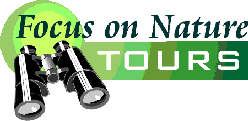

 MARINE LIFE
MARINE LIFE![]()





















